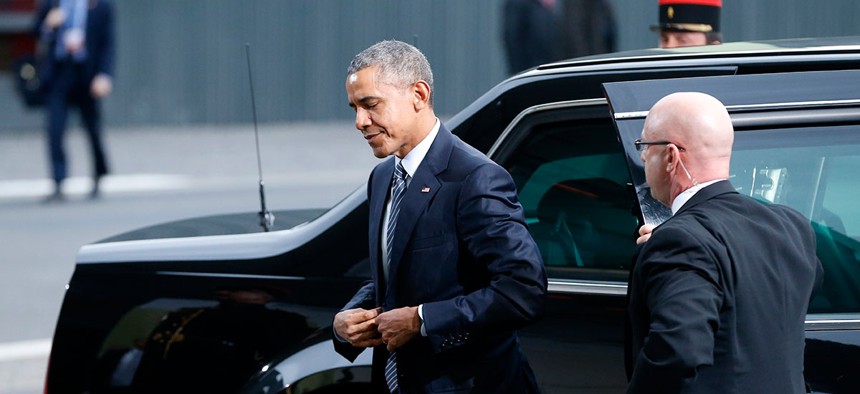
Barack Obama arrives for climate conference outside Paris on Monday. Guillaume Horcajuelo/AP
One Way Obama Can’t Outrun Congress on Climate Change
Big nations and private-sector titans arrived in Paris vowing to open their wallets for green energy technology. But can the U.S. make good on its promise?
Even a transatlantic flight can’t completely untether President Obama from congressional Republicans when it comes to cementing his legacy on climate change.
When high-stakes United Nations talks on a new global climate pact open Monday in Paris, Obama and more than a dozen other world leaders will pledge a huge boost in research-and-development funding for low-carbon energy technologies.
Twenty nations will unveil “Mission Innovation,” a joint plan to double their annual R&D investments over the next five years. According to a top White House climate policy adviser, the countries currently invest a total of about $10 billion annually, about half of which comes from the U.S.
But the U.S. government’s energy R&D spending has beenlargely stagnant in recent years, and the U.S. portion of the pledge is reliant on convincing Congress to open its wallet in the name of battling climate change, a threat that many Republicans downplay or even don’t acknowledge.
Relying on the good graces of Congress to make progress on climate change is something that Obama has generally sought to avoid for several years.
Since Congress approved the big stimulus law that funded a suite of energy efforts in 2009—and subsequently killed cap-and-trade legislation in 2010—nearly all of Obama’s climate agenda has rested on executive actions, ranging from much tougher auto-mileage rules to sweeping carbon-emissions limits for power plants that were finalized last summer.
And U.S. officials are pushing for the Paris accord to be crafted in a way that won’t need Senate sign-off the way that formal new treaties do, largely because there’s almost no chance of winning the two-thirds vote that would be needed.
But a big part of the Paris talks will be about mobilizing the public-sector and private-sector cash needed to develop and deploy green energy technology more widely worldwide. That takes government money, and in the U.S., that means it takes Congress.
And already, Republicans are resisting a White House request for a separate pot of money: the $3 billion that the U.S. pledged last year to the Green Climate Fund, a multilateral program to help poor nations cut emissions and become more resilient to rising sea levels and other unavoidable climatic changes. The White House has a pending request for a $500 million tranche of that money.
Still, getting Congress to help with the new and separate R&D initiative, even if Capitol Hill remains controlled by the GOP, may not be pie in the sky. Republicans are generally more friendly to basic research than to regulations or to direct support for clean-tech companies through loans and tax subsidies.
Consider that the Energy Department branch for funding so-called high-risk, high-reward energy-tech research, called the Advanced Research Projects Agency for Energy (ARPA-E), has had bipartisan support for years.
And while Jeb Bush’s energy plan is a set of familiar anti-regulatory talking points, near the end he notes: “[W]e can further accelerate the discovery of game-changing technologies by boosting funding for high-priority basic research and increasing the effectiveness of our national labs.”
Top Obama administration officials argued Sunday that the R&D funding plan has appeal on both sides of the aisle.
“The innovation agenda in general is one that actually does attract bipartisan support,” Energy Secretary Ernest Moniz told reporters on a conference call Sunday. “I certainly have spoken with many members on both sides of the aisle, quite frankly, just in the last few days, and the innovation agenda is one that attracts broad support,” Moniz said
White House climate adviser Brian Deese said the Mission Innovation effort is the fruit of an “intense diplomatic effort” in recent weeks. The 19 other nations involved include China and India, which respectively are the world’s largest and third-largest greenhouse gas polluters (the U.S. is second). Others include Saudi Arabia, Brazil, Indonesia, Denmark, Canada, Mexico, and Japan.
“This is an effort designed to accelerate clean-energy innovation, address global climate change, provide affordable clean energy to consumers with a special focus on the developing world, and creating commercial opportunities for clean energy in developing countries,” said Deese, who briefed reporters Sunday.
The multilateral Mission Innovation effort is one half of a public-private announcement as the Paris climate summit opens. The other half is the launch of an initiative led by Microsoft founder and philanthropist Bill Gates called the Breakthrough Energy Coalition that officials hope will complement the stepped-up R&D.
It’s an effort by high-profile private investors and corporate executives to greatly increase assistance for companies seeking to bring promising new energy technologies from the lab into real-world deployment, a gap often called the “Valley of Death” because it’s where many companies fail.
The group includes Gates, Facebook’s Mark Zuckerberg, Hewlett-Packard CEO Meg Whitman, billionaire activists George Soros and Tom Steyer, and 23 others from multiple countries. It’s designed to work in tandem with the government R&D funding boost. Here’s part of the lengthy joint statement that the investors released Sunday evening:
“Experience indicates that even the most promising ideas face daunting commercialization challenges and a nearly impassable Valley of Death between promising concept and viable product, which neither government funding nor conventional private investment can bridge. This collective failure can be addressed, in part, by a dramatically scaled-up public research pipeline, linked to a different kind of private investor with a long-term commitment to new technologies who is willing to put truly patient flexible risk capital to work.”
There’s a reason for all the focus on R&D and getting the fruit of lab work into the global energy market.
International negotiations are aimed at trying to limit the rise in global temperatures to 2 degrees Celsius above preindustrial levels, which scientists say would help avoid some of the most dangerous effects of climate change.
But experts say that the carbon-cutting pledges called “Intended Nationally Determined Contributions” that nations have submitted to the United Nations, which last through 2025 or 2030, won’t tame global emissions enough to stay under that target. So work to bring emerging technologies and steeper cost reductions into the market—and relatively quickly—is needed.
“For all of the progress that has [been] made, those INDCs alone are not sufficient,” Deese told reporters. “We know that we are going to need to do more to mobilize financial support for low-carbon development in the countries that need it.”







